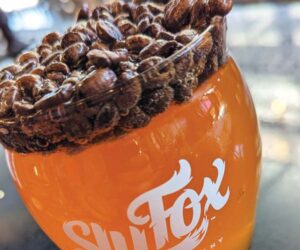Tropical Punch Red Ale
Tropical Red Ale
(5 gallons/19 L, partial mash)
OG = 1.061 FG = 1.014
IBU = 20 SRM = 15 ABV = 6.3%
Ingredients
2 lbs. (0.91 kg) two-row pale malt
1 lb. (0.45 kg) Munich malt
1 lb. (0.45 kg) medium crystal malt (50 to 60° L)
1 oz. (28 g) roasted barley
5 lbs. (2.3 kg) extra light dried malt extract
5 lbs. (2.3 kg) tropical fruit (see below)
3.6 AAU Warrior® hop pellets (45 min.) (0.25 oz./7 g at 14.5% alpha acid)
1 oz. (28 g) Simcoe® hop pellets (0 min.)
1.5 oz. (43 g) Citra® hop pellets (dry hop)
1.5 oz. (43 g) Galaxy hop pellets (dry hop)
Mangrove Jack’s M15 (Empire Ale) or Safale S-04 or Lallemand London ESB yeast
3/4 cup corn sugar (if priming)
Step by Step
Heat 1.5 gals. (5.7 L) of water to 163 °F (73 °C). Mix in pale, Munich, crystal malt and roasted barley (all crushed). The mash should settle at 150 to 152 °F (66 to 67 °C). Hold 60 minutes, then wash with 1.5 gals. (5.7 L) of water at 168 °F (76 °C). To the kettle add enough water to make at least 3 gals. (11 L) and bring the wort to a simmer. Remove from heat and add dried malt extract and Warrior® pellets. Bring back up to a boil and boil 45 minutes. Remove from heat and add the Simcoe® hops. Give wort a long stir to create a whirlpool and let settle for 15 minutes. Chill and top off with water to make 5.25 gals. in primary fermenter.
At 68 °F (20 °C) pitch a fruity, dry ale yeast. Ferment at 68 °F (20 °C) until initial fermentation cycle is complete. Rack to a secondary fermenter onto 5 lbs. (2.3 kg) of (your choice — any combination is cool!) pineapple, mango, banana, guava, papaya, passionfruit, starfruit, kiwi, lychee or orange. Secondary fermentation should last eight to 10 days, then re-rack to a third vessel to allow for clearing (a week or so should do it). Prime with corn sugar (add a few ounces of lactose if the beer seems too dry at this point). Bottle and age three to four weeks.
Alternatives and Options:
Obviously, the vast majority of alternatives in this recipe depend on your preferences for fruit. If it’s fruit, you can use it. Just remember that the fruit will give a different element depending on how you use it. Fruit in the boil will give flavor but not much aroma. Fruit steeped in the cooling wort will contribute a little aroma but may or may not get adequately pasteurized. Fruit added to the primary will give good, fresh flavor (and will contribute fermentables, raising alcohol content slightly), but most of the aroma will bubble out with the CO2.
My favorite technique, mentioned above, is to pasteurize the fruit (I freeze it for several weeks and then microwave it to thaw it, which also kills a lot of bacteria), then put it into the bottom of my secondary. A 6-gal. carboy for a 5-gal. batch allows room for the fruit and renewed fermentation activity — occasionally I even have to install a blowoff tube on the secondary if I’m using a lot of fruit.
I then rack the more or less finished beer onto the fruit after initial fermentation subsides. I almost always then rack it again to get the beer off the fruit and allow it to clear. You can enhance or add to fruit flavors by adding fruit essences, extracts, or liqueurs with your priming sugar.
All-grain brewers:
Simply add 9.5 lbs. (4.3 kg) more of the pale malt to the grain bill, increase the mash water to 17 qts. (16 L) and the sparge water to 3.5 gals (13.2 L). Time and temperature remain the same. Simmer as above and boil to reduce to 5.25 gals. (20 L), keeping in mind the hopping schedule suggested.
Written by Scott Russell
You maybe drinking the Kool-Aid after this one (don’t worry, there is no artificial drink mix required in this recipe, only fresh tropical fruit). Tropical fruit paired with tropical hops make for a complex beer with lots of fruit aroma and flavor going on.



